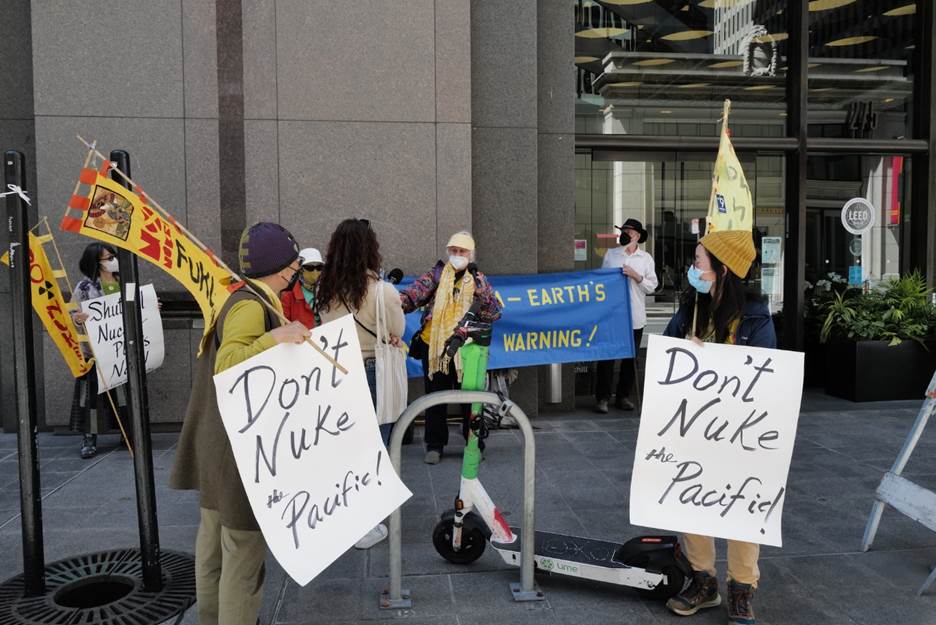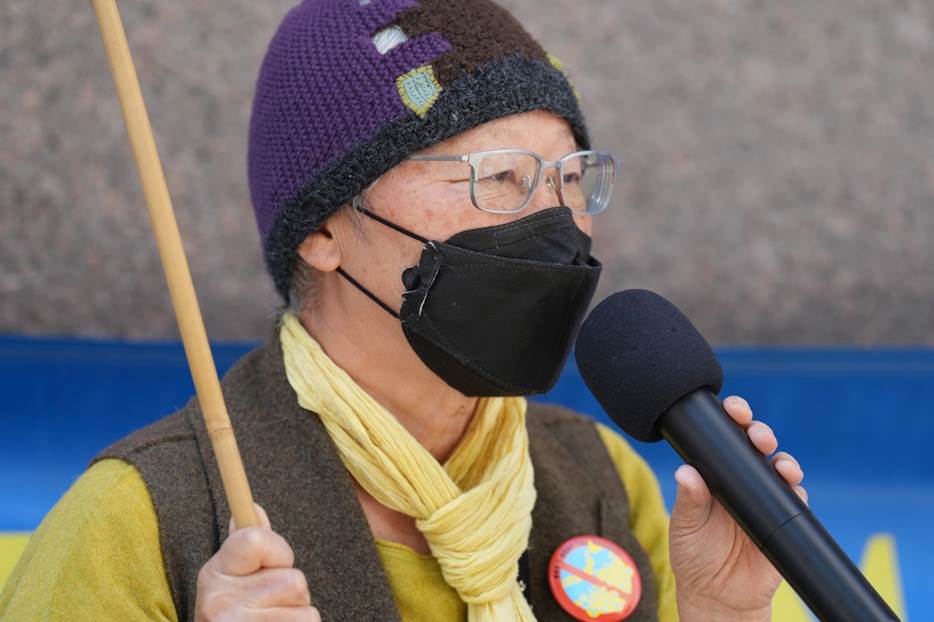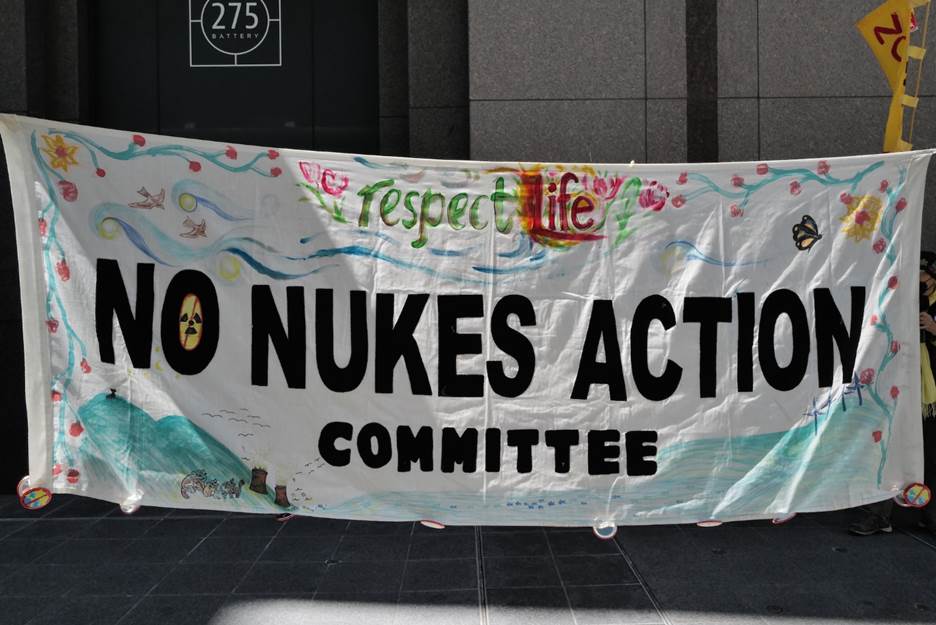


Japan Proposes to Dump Radioactive Water into the Pacific
Report and pictures by Phil Pasquini
Washington, DC

Activists took to the streets in San Francisco on April 13 in front of the Japanese Consulate to commemorate the 12th anniversary of the second worst nuclear power accident in history demanding the Japanese government not to allow the Tokyo Electric Power Company’s (TEPCO) to dump radioactive water from the Fukushima Daiichi Nuclear Power Station into the Pacific Ocean. They also called for “NO Nukes” for Japan and to shut down all nuclear power plants.
Today’s occasion was the 100th time the protesters have demonstrated at the Consulate against nuclear energy in warning of the ever-present Anthropocene pollution despoiling the planet. Chizu Hamada of “No Nukes Action” led a small group of dedicated activists in calling for the Japanese government not to release the radioactive water.
Noting that the Japanese people consume a great deal of fish and that the contamination posed by the waters released into the Pacific further increases the long-lasting negative health impacts for people. “The sea is life, a matter of survival” for the Japanese she said.
The ocean water off the coast of Fukushima was described in a Detusche Welle article from 2020 as having “…millions of times higher than the government's limit of 100 becquerels.” Marine life as far as 25 miles out to sea from the plant has been shown to have high radiation levels rendering fishing a nonstarter for locals.
“Our voices must be heard” was how Hamada expressed the need of attention to the looming disaster and noted too that there are still 30,000 people who cannot go back to their homes because of the meltdown. During her sidewalk talk she remarked how Japanese scientists studying the area have warned of the adverse effects that the release would have, which generally have been ignored.
Another speaker related how as a child in the1940s and 50s she would accompany her scientist father who was studying tunicates attached to boats when he discovered that they were radioactive. He was able to determine that the source of the radiation could be attributed to nuclear bomb detonation tests in the South Pacific. A study published in the Marine Pollution Bulletin in 1977 noted that tunicates “…may serve as marine pollution indicators for monitoring the release of radioactive elements into the marine environment.” Their ability to accumulate certain trace radioactive elements can be used to determine the extent of marine radioactive pollution making them the perfect canary in the sea.
The event that caused the present problem at Fukushima was the 9.0-magnitude Great East Japan Earthquake on March 11, 2011. It was the largest ever recorded to hit the island nation and caused a 46-foot-high tsunami (tidal wave) to strike the plant. With only a ten-minute warning to shut down its reactors, the tsunami damaged the plant’s emergency backup generators shutting off power to its water-coolant pumps for the reactor’s cores. At the time of the earthquake radioactive water from the plant flowed into the ocean in “unprecedented” volume.
The tsunami’s impact resulted in 18,000 deaths, displaced 160,000 people and was so powerful that it shifted the Earth off its axis by an estimated 6.5 inches increasing its rotation that may have resulted in shortening our days according to a NASA estimate.
Heat generated from the rods in the cores was so intense in reactor number one that it melted the concrete structure supporting the containment vessel leaving it precariously suspended and in danger of collapse. During the following days, the cores overheated leading to the meltdown accompanied by hydrogen explosions. Radioactive material and water were in turn released into the ocean and the surrounding area prompting the evacuation of a wide zone around the plant.
In the twelve years since the accident, according to activists, there are “1.3 million tons” of contaminated water that the government and TEPCO now want to dispose of by dumping into the Pacific Ocean. The company claims that the water is safe and has been treated by an “advanced treating system” (ALPS) to prepare it for release. But according to a report in the Global Times published on March 27, the treated water “…still contains radionuclides that are not able to be removed…including ruthenium, strontium-90 and iodine-129, in addition to tritium.” Greenpeace also begs to differ from the TEPCO appraisal of the water by stating that “the water contains materials (carbon-14) that could potentially damage human DNA.”
The plan approved by Japan’s nuclear regulators calls for the construction of an undersea tunnel to run from the plant less than a mile out into the ocean where it would enter the water at a depth of 40 feet. The release has been scheduled to begin this spring even as scientists have warned of disastrous effects on the marine environment from the discharge that would see the water travel with currents across the Pacific Ocean. Along with the Japanese people, China, Micronesia, Russia, South Korea, Taiwan and the US governments have all expressed strong opposition to the planned release. The Japanese government along with TEPCO have decided that it is cheaper to release the water into the ocean by applying the old “out of sight, out of mind” principal that has historically failed to ever remedy anything. Once it is released, there is no going back.
The radioactive waters’ release is the stuff of so many Japanese science fiction movies from the 1950s based on nuclear scenarios of giant monsters attacking Tokyo like the movie “Godzilla” that promoted the oversize T-Rex-like monster as “Surging up from the depths of the sea on a tidal wave of terror” along with the movie “The H-Man” that warned of the dangers of nuclear testing.
In his review of Godzilla, Brian Merchant in a Vice Magazine article dated August 23, 2013, referred to the film as “a bleak, powerful metaphor for nuclear power that still endures today… [a] deceptively powerful film about coping with and taking responsibility for incomprehensible, manmade tragedy, specifically, nuclear tragedies.”
But this is no movie and the waters’ release if it proceeds is yet another chapter of our blatant disregard for the long-term health of our planet and that of future generations. And who knows what form of a Godzillaesque creation will emerge in turn to come back and haunt us.
(Phil Pasquini is a freelance journalist and photographer. His reports and photographs appear in the Washington Report on Middle East Affairs and Nuze.ink. He is the author of Domes, Arches and Minarets: A History of Islamic-Inspired Buildings in America.)

